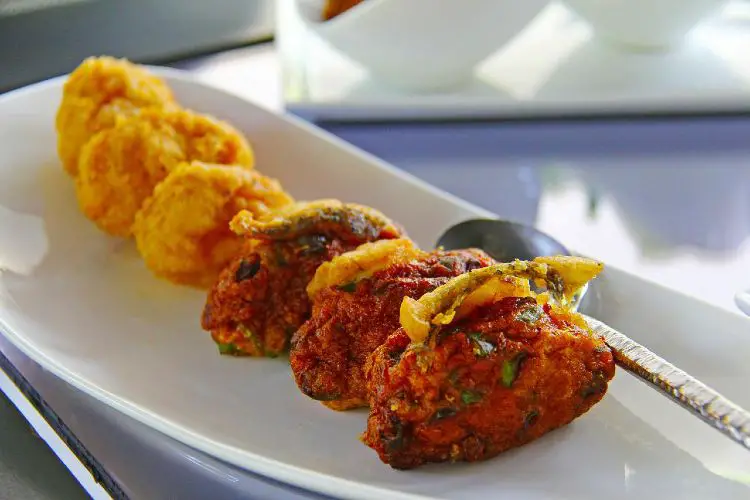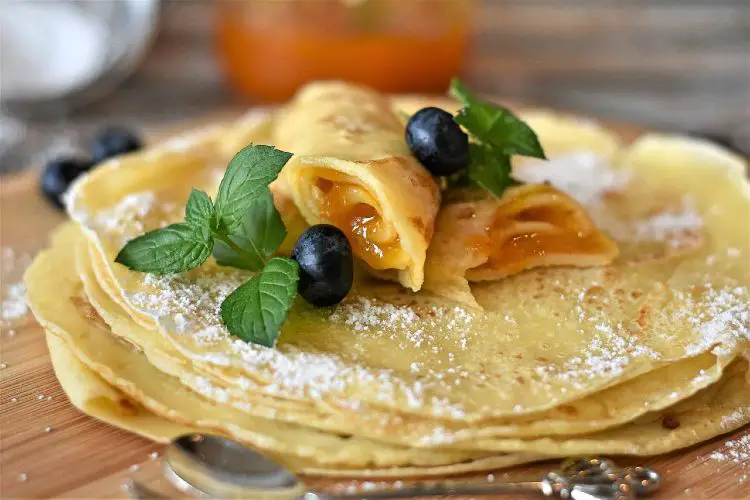Lunch with Claudia Roden, Eating and Talking “The Food of Spain”
Claudia Roden’s North London home is tucked away at the very bottom of a leafy, peaceful cul-de-sac, so demure in its Arts and Crafts perfection that you would imagine yourself in a little provincial village in the sleepy shires. In her billowing English garden we are so far away from her cosmopolitan Egyptian roots. Once inside, however, all around me in the kitchen and dining room are the reminders of her Middle Eastern and Mediterranean travels and childhood: from floor to ceiling from tables to rugs, this home houses the familial collection of a peripatetic life. It is the almond eyes, gentle manner and soft French intonations that betray Claudia’s origins – and the courteous politeness she bestows upon me as a stranger in her home.
“Thank-you for taking an interest,” she tells me, as she welcomes me to her table with fresh coffee and torta de aceite. Author of eleven books, winner of six Glenfiddich Awards, Claudia has also been awarded the most prestigious gastronomic awards in Italy, The Premio Orio Vergani and the Premio Maria Luigia Duchessa di Parma as well as The Versailles Award for achievement in France and the International Prince Claus Award for Culture from The Netherlands. And in all her modesty she thinks it is very kind that I should deem her worthy to be interviewed on her most recent work, “The Food of Spain”. Her James Beard Award medals hang from stripy ribbons on the door post, next to ladles, keys and spoons, as if they were ordinary, utilitarian objects. She has little idea of her exalted status amongst her cookery book fans, and so I tell her, much to her surprise.
We start talking about social media, a subject which Claudia says, has enthralled her six grandchildren but continues to baffle and defeat her.
“For those of us who belong to a generation that did everything by long-hand, this brave new world feels awesome. I find myself distracted enough just answering e-mails, let alone having to do Twitter or Facebook. I am always out and about, always learning, researching and interested. I am in a state I call quiet absorption – I have to know everything about a subject before I feel confident and knowledgeable enough to be able to write about it. But I do realise that I have to learn how to cope with this modern technology too, so I will learn.”
She lives alone in the house she bought thirty years ago, to be near to family and friends. Her parents moved to north London from Cairo at the time of the Suez crisis in the Summer of 1956. This diplomatic and military confrontation, precipitated by President Gamal Abdel’s decision to nationalise the Suez Canal, created a diaspora of exiled Jews, many families scattering across the world in search of a new life and prosperity.
Claudia’s father was Cesar Douek and her mother Nelly Sassoon, her family were wealthy Syrian silk merchants originally from Aleppo. Born in 1936, Claudia was sent to school in both London and Paris, and was used to a cosmopolitan life and fluency in different languages from a very early age, visiting relatives all over the world. When the family emigrated to Britain for good she was twenty years old and found that one way of preserving, evoking and cherishing the memories of better times was through food. A Sephardic Jew writing about the Muslim world, Claudia knows well the feeling of alienation and displacement.
In her work she has always sought out recipes and family cookery traditions of empires from the Ottoman to the Arab, Greek, Turkish, Phoenician and Roman, for it is in understanding a nation’s culinary heritage that we begin to appreciate its identity and civilisation. Displaced races often carry memories of their homeland’s ingredients and dishes as a psychological comfort against the harsh, isolating reality of living abroad. Claudia has no intention of stopping her research or feeling left out.
“I am 75 now and I still have not retired. I will never retire. I am very busy on a new project to update “The Food of Italy”, because, you see, cookery does not stand still in time. Modernity brings new cookery gadgets, new sources of ingredients and new ways of thinking, which is why books need updating. I am already working on two new projects.”
The table I am writing my interview notes on is the same one where countless friends have eaten the results of the hundreds of recipes she tests and retests for every book.
“It’s one of the great pleasures of being a food writer – you can invite all your friends around to feed them the fruits of your labours.”
When Claudia first started her research for “The Food of Italy” in 1989, the founder of the Italian culinary academy, l’Accademia Italiana della Cucina, Massimo Alberini, invited her to a banquet at the Gritti Palace in Venice where a grand conference was taking place amongst the best Italian chefs. The President of the association of food lovers, gli appassionati di cucina, gave her a long list of contacts for Claudia to meet to learn more about the traditions of homecooks and the history of what produce is grown in the region. She attended cookery schools, stayed in rural B and B’s and met food and drink artisans that had never before been showcased by British publishers.
And so it was with “The Food of Spain”, published by Michael Joseph, an imprint of Penguin. Claudia spent five years staying with friends and friends of friends, at monasteries and farmhouses, meeting smallholders, fishmongers and chorizo makers, visiting food and drink emporia, restaurants, bars, street stalls and cafes, the plebeian repositories of the secrets of the oral, folkloric, often matriarchal, culinary traditions of Spain.
“I want to meet the real cooks, the working people who grow and prepare food themselves. I am not really interested in the latest innovations, because I believe that some of the new creations are detached from reality. I arrive with my notebook and pen in hand, I write everything in longhand, and I ask: What is your favourite family recipe? Who were your parents and which region did they come from? What did they do? What meals do you remember from your childhood? When I was travelling through Spain I found that people really loved to tell their stories. Once people are in a kitchen they open up, they tell you their memories and worries. Food is totally gripping, moving, so exciting.”
It is the vast network of contacts listed inside Claudia’s notebooks, gained over thirty years of collecting information, that television researchers and publishers come to raid whenever other Italian food writers need to make a television series or start their new recipe book. She is the touchstone of authenticity, a subject that is of great concern to many food writers now that there is a proliferation of free recipes on the Internet.
“One of my daughter’s friends asked her what her mother did. And my daughter replied that I wrote about, and cooked, traditional food. Her friend commented how “weird” that was. She wanted to know why I did not put my own “twist” on recipes. I once saw a “Risotto Tricolore” on a Menu. Can you imagine ratatouille with a twist? Or latkes? A magazine editor once contacted me to ask whether I could write a recipe for latkes, omitting the potatoes but using courgettes instead. These are the Jewish potato pancakes traditionally served during Hanukkah. Heritage, cultural identity and traditions have to be changed to suit the requirements of ever-changing fashions, and I think this is wrong.”
In “The Food of Spain” you are immediately drawn into the confluence of Muslim, Roman, Celtic, Jewish, French, peasant, aristocratic, secular, religious and political imprints that created the many different regional influences on Spain’s gastronomic narrative. Over 500 pages long, spanning 2500 years of invasions, foreign rule and, at times, fragile settlement the book celebrates the ingredients, utensils, techniques, cooks, mothers, teachers and food historians of this vast, brave and colourful nation.
The beauty of the book will astonish you: food photography by Jason Lowe, tile paintings by Tina Hannay and design by John Hamilton and Sarah Fraser all combine to create a precious, heirloom production, with maiolica tiled covers, detailed maps and wide streetscapes and architectural features lifting you out of your armchair and into the hot, sunny boulevards of Valencia, Cadiz and Oviedo. The commercial imperatives underpinning publishing remain the same: the books that sell well in this current economic climate are the books that are beautiful. Claudia understands the aesthetic importance of authenticity in photography and styling as well as in recipe writing.
“I thought it was very important with the photo styling that we did not include chipped plates, old women cooking by the fireside or donkeys carrying bread: this is not the real Spain. The middle classes, the bourgeoisie, aspire to have French and Italian plates on their dining room tables, they travel, they have assimilated and adopted ideas over time. It is important to keep reality clear and not make things romantically and nostalgically appear what they are not.”
She prepared a delicious lunch for me: Patatas a la riojiana {page 430 of the book}, soft, floury potatoes cooked for half an hour with onions, garlic, pimenton and chorizo; Pipirrana {page 217}, a salad of roasted peppers and tomatoes, the food of agricultural labourers from Andalucia, Murcia and Castile-La Mancha, accompanied by softly boiled fennel and artichoke hearts. For pudding she served Helado de pasas y vino dulce, a raisin and sweet white wine ice-cream {page 453}.
Whilst we ate she talked about her local shops: living in this part of London she is fortunate to have an array of Indian supermarkets, halal and kosher butcheries and Iranian food shops. She hops on and off buses, carries her own shopping bags everywhere, and looks surprised when a younger person offers her their seat on the underground or on the bus.
“In my mind I still think of myself as if I were a young girl. I am completely independent. When we left Egypt I felt that many of the women of my mother’s generation, in their forties, were completely helpless. They had lived a life of luxury, where servants carried their suitcases and cooked for them. Eastern European girls would come to Egypt, leaving their own children behind, in order to look after the Egyptian and Jewish families’ children. I saw what happened to the Egyptian women when their wealth was taken away, and I was always determined to be able to fend for myself.”
She is, above all, glad to see that young people, all over the world, are keen to reproduce the cookery of their grandmothers, and there is a renewed interest in a subject once considered untrendy and old-fashioned. Claudia has much to be proud of: her son, Simon Roden, is an accomplished architect, her daughter Anna is a fund manager and her other daughter Nadia makes artisanal ice-cream. Her grandson Cesar co-founded Rococo Pod, selling artisanal chocolates, ice-creams and coffees from a small van. Chantal Coady, founder of Rococo, is the sister of Claudia’s daughter-in-law, and the family are very close friends.
She welcomes all the new faces on the cookery scene: from Jamie Oliver to Rachel Khoo, Sam and Sam Moro and Allegra McEvedy, she believes that the more the love of good homecooking spreads, the better for our society and our culture. Ultimately, it is this openess, willingness to share and constant quest for learning that holds Claudia so high in readers’ esteem, throughout the world. No Twitter account necessary, methinks.
Further information
“The Food of Spain”, written by Claudia Roden and photographed by Jason Lowe, is published by Michael Joseph at www.penguin.co.uk.
Follow the team on Twitter: @PenguinBooks


